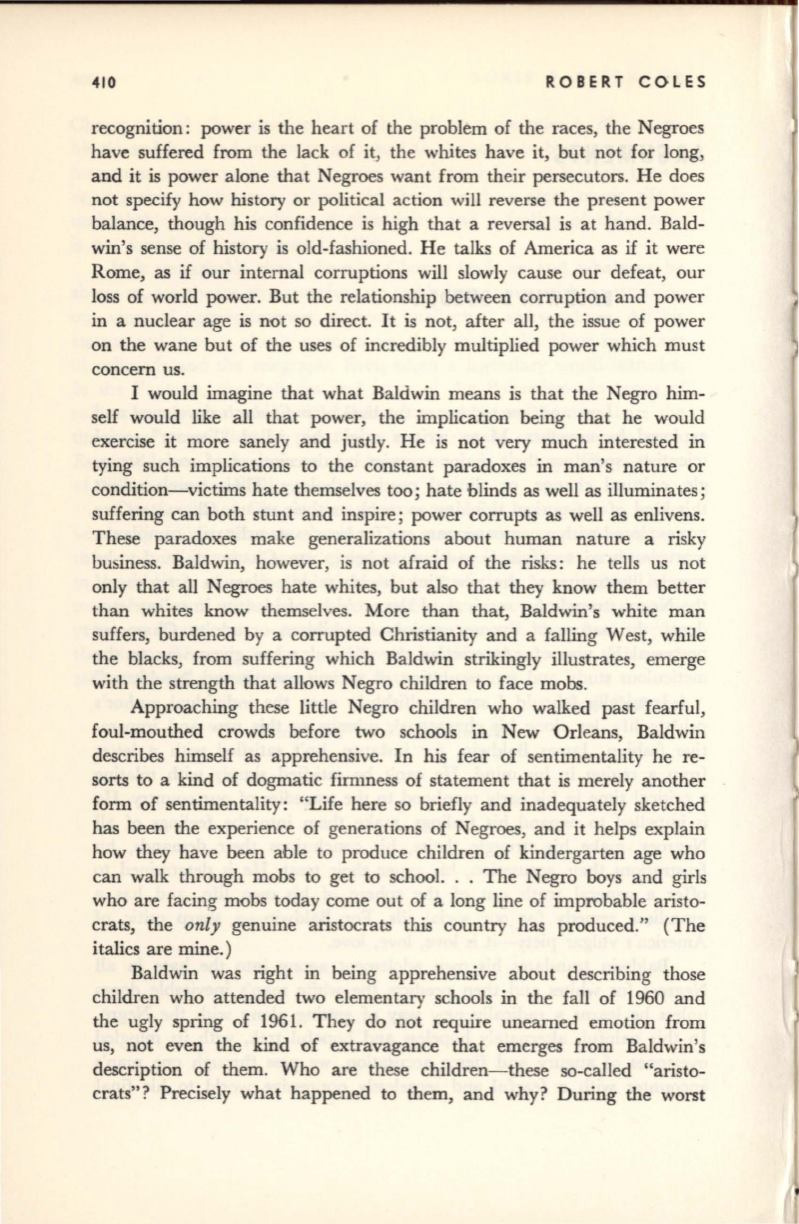
4'0
ROBERT COLES
recogmtlon: power is the heart of the problem of the races, the Negroes
have suffered from the lack of it, the whites have it, but not for long,
and it is power alone that Negroes want from their persecutors. He does
not specify how history or political action will reverse the present power
balance, though his confidence is high that a reversal
is
at hand. Bald–
win's sense of history is old-fashioned. He talks of America as if
it
were
Rome, as
if
our internal corruptions will slowly cause our defeat, our
loss of world power. But the relationship between corruption and power
in a nuclear age is not so direct. It is not, after all, the issue of power
on the wane but of the uses of incredibly multiplied power which must
concern us.
I would imagine that what Baldwin means is that the Negro him–
self would like all that power, the implication being that he would
exercise it more sanely and justly. He is not very much interested in
tying such implications to the constant paradoxes in man's nature or
condition-victims hate themselves too; hate blinds as well as illuminates;
suffering can both stunt and inspire; power corrupts as well as enlivens.
These paradoxes make generalizations about human nature a risky
business. Baldwin, however, is not afraid of the risks: he tells us not
only that all Negroes hate whites, but also that they know them better
than whites know themselves. More than that, Baldwin's white man
suffers, burdened by a corrupted Christianity and a falling West, while
the blacks, from suffering which Baldwin strikingly illustrates, emerge
with the strength that allows Negro children to face mobs.
Approaching these little Negro children who walked past fearful,
foul-mouthed crowds before two schools in New Orleans, Baldwin
describes himself as apprehensive. In his fear of sentimentality he re–
sorts to a kind of dogmatic firmness of statement that is merely another
form of sentimentality: "Life here so briefly and inadequately sketched
has been the experience of generations of Negroes, and it helps explain
how they have been able to produce children of kindergarten age who
can walk through mobs to get to school. .. The Negro boys and girls
who are facing mobs today come out of a long line of improbable aristo–
crats, the
only
genuine aristocrats this country has produced." (The
italics are mine.)
Baldwin was right in being apprehensive about describing those
children who attended two elementary schools in the fall of
1960
and
the ugly spring of 1961. They do not require unearned emotion from
us, not even the kind of extravagance that emerges from Baldwin's
description of them. Who are these children-these so-called "aristo–
crats"? Precisely what happened to them, and why? During the worst


